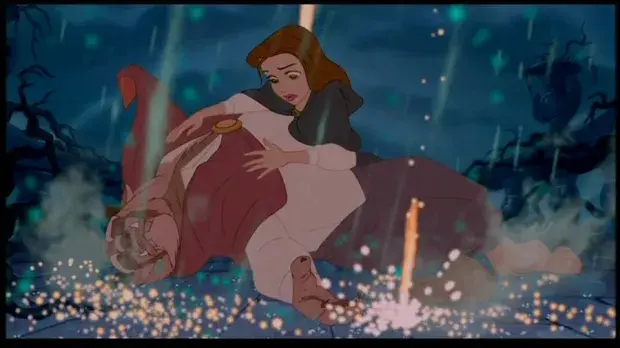Beast’s Hands and Rodin’s Influence: Art History Easter Eggs in Beauty and the Beast
- Dr. Lauren Kilroy-Ewbank

- Mar 13
- 4 min read
Updated: Mar 14

Have you ever noticed how much focus there is on the Beast’s hands in Beauty and the Beast? From his ferocious paws to his graceful, human-like hands during the iconic transformation scene at the end, hands play a surprisingly prominent role in conveying the character’s emotional journey. Or so I'd argue.

As someone who’s always been fascinated by hands (and once spent countless hours painting and sketching them as a serious artist), I couldn’t help but notice this artistic choice. And it turns out that Disney artists didn’t just randomly decide to highlight the Beast’s hands—they found inspiration in none other than Auguste Rodin, the famous 19th-century French sculptor known for his interest in "the expressive power of hands." [1]
Side note: I, too, am obsessed with Rodin's hands, and I sketched them over and over one summer when I studied in Paris.

Rodin’s Fascination with Hands
Auguste Rodin, one of the most influential sculptors of the 19th century, was famously captivated by the human hand. Actually, captivated is too light a word. Obsessed is more accurate. He believed hands could communicate complex emotions—from anguish and despair to hope and love—without words. His sculptures often focused on hands as part of larger compositions or as standalone pieces.
"Rodin is the sculptor of hands—furious, clenched, rearing, damned hands."—French critic and poet Gustave Kahn, in Auguste Rodin (Librarie artistique et littéraire, 1906)

At museums like the Rodin Museum in Paris and the Philadelphia Museum of Art, you can see some of his most famous works featuring hands, including The Cathedral, The Clenched Hand, and The Burghers of Calais. These pieces demonstrate Rodin’s belief that hands could be just as expressive as faces, if not more so.
There are among the works of Rodin's hands, single small hands, which without belonging to a body, are alive. Hands that rise, irritated and in wrath; hands whose five bristling fingers seem to bark like the five jaws of a dog of Hell.—Poet Rainer Maria Rilke

The Beast’s Hands in Beauty and the Beast
Given Rodin’s obsession with hands and their emotional power, it’s no surprise that Disney artists may have drawn inspiration from his work when animating the Beast. Throughout Beauty and the Beast, the Beast’s hands express a wide range of emotions—from rage and sorrow to tenderness and vulnerability.

One of the most striking moments involving the Beast’s hands is during the transformation scene. As the magic takes hold, his claws morph into human hands, symbolizing a physical change and emotional growth. The focus on his hands in this scene is a powerful visual cue that underscores his character's transformation from beastly to human.

A Fitting French Connection
The connection between Rodin and Beauty and the Beast goes beyond artistic inspiration—it also fits perfectly with the film's setting. Since the story takes place in France, it makes sense that Disney would draw on French art and culture when designing the characters and their emotional arcs. By channeling Rodin’s philosophy about the expressive potential of hands, the animators could add depth and nuance to the Beast’s character.

The Art of Hands in Storytelling
Hands have always played a crucial role in art and storytelling. They can convey emotions, tell stories, and symbolize transformation. In the case of Beauty and the Beast, the focus on the Beast’s hands serves as a subtle yet powerful narrative device, helping to tell the story of a character who undergoes both an emotional and physical metamorphosis.

This artistic choice elevates the film beyond a simple fairy tale, turning it into a deeply emotional and visually rich experience. It’s another example of how Disney artists draw on the great masters of art history to create timeless animation works.
A Tale As Old as Time: Art History Easter Eggs in Beauty and the Beast
The next time you watch Beauty and the Beast, take a moment to appreciate the focus on the Beast’s hands. It’s not just a clever animation choice—it’s a nod to the timeless power of art and its ability to convey the most profound human emotions. Whether through Rodin's masterful sculptures or Disney's carefully crafted animation, hands remain a universal symbol of connection, transformation, and expression.
Plus, Rodin is just incredible. If you ever get to see his sculptures in person, run!
Let me know in the comments what you think about the Beast and Rodin. Do you see the connection?
Notes
[1] "Rodin's Hands" from the Rodin Museum, Paris
CITE THIS PAGE: Kilroy-Ewbank, Dr. Lauren. "Beast’s Hands and Rodin’s Influence: Art History Easter Eggs in Beauty and the Beast." lkilroyewbank.com <Insert date you accessed> URL.
Learn more
A short essay about Auguste Rodin on The Heilbrunn Timeline
A longer biographical essay about Rodin from the National Gallery of Art







Comments